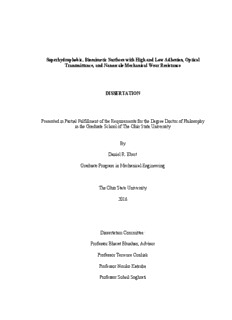
Superhydrophobic, Biomimetic Surfaces with High and Low Adhesion, Optical Transmittance, and ... PDF
Preview Superhydrophobic, Biomimetic Surfaces with High and Low Adhesion, Optical Transmittance, and ...
Superhydrophobic, Biomimetic Surfaces with High and Low Adhesion, Optical Transmittance, and Nanoscale Mechanical Wear Resistance DISSERTATION Presented in Partial Fulfillment of the Requirements for the Degree Doctor of Philosophy in the Graduate School of The Ohio State University By Daniel R. Ebert Graduate Program in Mechanical Engineering The Ohio State University 2016 Dissertation Committee: Professor Bharat Bhushan, Advisor Professor Terrence Conlisk Professor Noriko Katsube Professor Soheil Soghrati Copyrighted by Daniel R. Ebert 2016 ABSTRACT Superhydrophobic surfaces (defined as surfaces having water contact angle greater than 150°) show great promise for use in a rapidly growing number of engineering applications, ranging from biomedical devices to fluid drag reduction in pipelines. In nature, the surfaces of many organisms, such as certain plant leaves, are known to exhibit superhydrophobicity. In some cases, droplet adhesion is very low (droplet rolls away easily), while in other cases adhesion is high (droplet remains adhered when surface is inverted). The recent advent and development of microscopes with resolution down to a few nanometers (such as atomic force microscopes and scanning electron microscopes) has allowed for in-depth understanding of the micro- and nanoscale mechanisms employed by these plant leaves and other natural surfaces to achieve their particular wetting properties. Biomimetics (or “mimicking nature”) is therefore a very promising approach for the development of engineering surfaces with desired wetting characteristics. However, research in creating biomimetic surfaces is still in its early stages, and many of the surfaces created thus far are not mechanically robust, which is required for many potential real-world applications. In addition, for applications such as self-cleaning windows and solar panels, optical transparency is required. ii In this thesis, a set of original studies are presented in which superhydrophobic surfaces were designed based on biomimetics and fabricated using a wide of variety of techniques. The surfaces were characterized with regard to wetting characteristics such as water contact angle and contact angle hysteresis, micro- and nanoscale mechanical durability, and in some cases optical transmittance. Theoretical wetting models served as guides both in the design and in the understanding of experimental results, especially in regard to different wetting regime and regime transition. This work provides important conclusions and valuable insight for identifying materials, techniques, and designs for mechanically durable, optically transparent superhydrophobic surfaces. iii Dedicated to my parents iv ACKNOWLEDGMENTS I would like to thank first and foremost my research advisor, Professor Bharat Bhushan, for working with me at every step of this long journey. I have made enormous strides professionally because of his guidance and tutelage. Next I would like to thank my fellow researchers at NLBB, especially Dr. Manuel Palacio and Dr. Philip Brown, who provided critical assistance with my work in the lab. I thank the graduate advising staff of the mechanical engineering department, as well as my doctoral committee members, Professor Terrence Conlisk, Professor Noriko Katsube, and Professor Soheil Soghrati. I thank The Ohio State University for a full undergraduate scholarship, for countless academic, research, and teaching opportunities, and for so many memorable experiences. Lastly I want to thank my family, my true friends, and all of my teachers throughout my life. v VITA 2002………………………………………….……………...Beavercreek High School Beavercreek, Ohio, USA 2008………………………………………….……………...B.S. Mechanical Engineering The Ohio State University 2012……………………………………………………........M.S. Mechanical Engineering The Ohio State University PUBLICATIONS 1. Ebert, D. and Bhushan, B. (2012a), “Durable Lotus-effect surfaces with hierarchical structure using micro- and nanosized hydrophobic silica particles,” J. Colloid Interf. Sci. 368, 584-591 2. Ebert, D. and Bhushan, B. (2012b), “Wear-resistant rose petal-effect surfaces with superhydrophobicity and high droplet adhesion using hydrophobic and hydrophilic nanoparticles,” J. Colloid Interf. Sci. 384, 182-188 3. Ebert, D. and Bhushan, B. (2012c), “Transparent, Superhydrophobic, and Wear- Resistant Coatings on Glass and Polymer Substrates Using SiO , ZnO, and ITO 2 Nanoparticles,” Langmuir 28, 11391–11399 vi 4. Ebert, D.R. and Bhushan, B. (2013), “Methods of Fabricating Superhydrophobic, Optically Transparent Surfaces,” U.S. Patent Pending 5. Ebert, D. and Bhushan, B. (2016), “Transparent, superhydrophobic, and wear- resistant surfaces using deep reactive ion etching on PDMS substrates,” J. Colloid Interf. Sci. 481, 82-90 FIELDS OF STUDY Major Field: Mechanical Engineering vii TABLE OF CONTENTS ABSTRACT ........................................................................................................................ ii ACKNOWLEDGMENTS .................................................................................................. v VITA .................................................................................................................................. vi LIST OF TABLES ............................................................................................................ xii LIST OF FIGURES ......................................................................................................... xiv CHAPTER 1: Introduction ................................................................................................ 1 1.1 Significance of the problem ...................................................................................... 1 1.2 Overview of surface wettability and superhydrophobicity ....................................... 2 1.3 Biomimetics and extreme wettability found in nature ............................................ 14 1.4 Scope of the thesis ................................................................................................... 19 CHAPTER 2: Lotus Effect Surfaces with Superhydrophobicity and Low Droplet Adhesion ........................................................................................................................... 23 2.1 Introduction ............................................................................................................. 23 2.2 Overview of wettability on a patterned surface ...................................................... 25 2.3 Sample preparation and characterization ................................................................ 27 viii
Description: